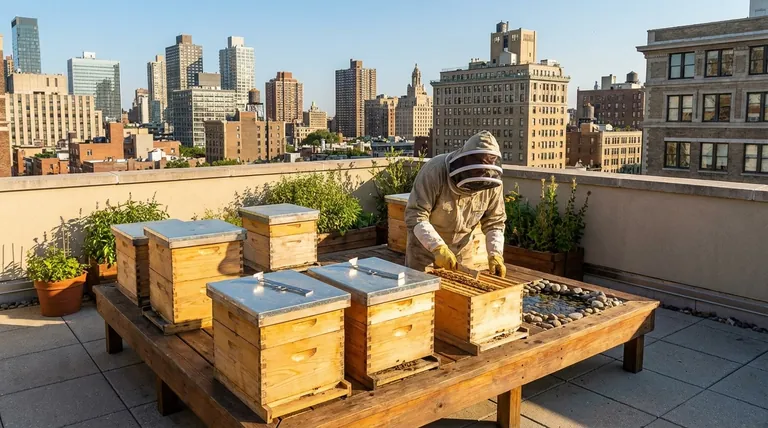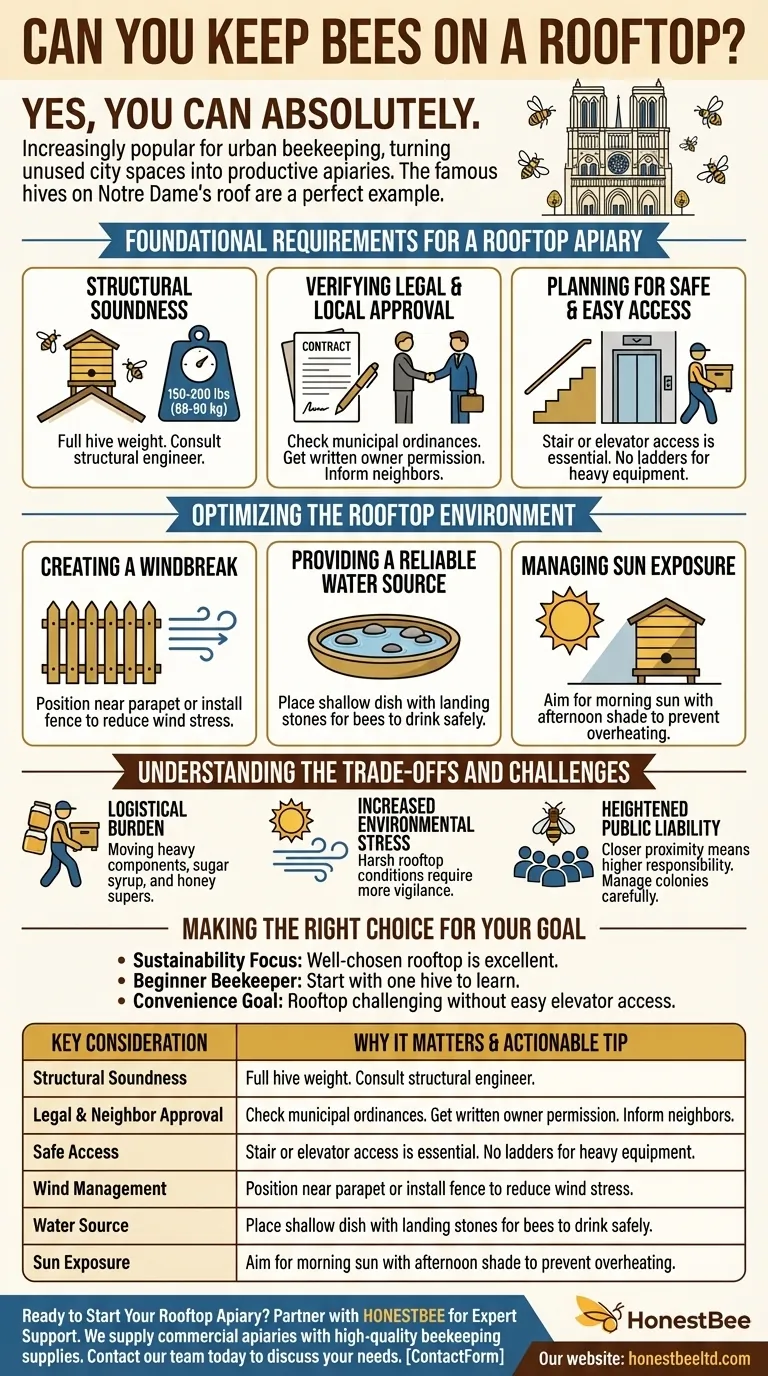Yes, you can absolutely keep bees on a rooftop. In fact, it is an increasingly popular and effective method for urban beekeeping, turning unused city spaces into productive apiaries. The famous hives on the roof of the Notre Dame cathedral are a perfect example of how viable this practice is.
Rooftop beekeeping is entirely feasible, but success hinges on more than just available space. Your primary considerations must be the structural integrity of the roof, the unique environmental challenges like wind and sun, and safe, practical access for you and your equipment.

Foundational Requirements for a Rooftop Apiary
Before placing a hive, you must address several critical safety and logistical factors. These non-negotiable steps ensure the well-being of your bees, yourself, and the public.
Ensuring Structural Soundness
A single beehive can become surprisingly heavy. When filled with honey, brood, and bees, a complete hive can easily weigh 150-200 pounds (68-90 kg) or more.
You must confirm the roof can support this concentrated load, especially if you plan on having multiple hives. For any uncertainty, consulting a structural engineer is the most responsible course of action.
Verifying Legal and Local Approval
Check your local municipal ordinances regarding beekeeping. Additionally, if you do not own the building, you must get explicit, written permission from the building owner or management company.
It is also wise to inform your immediate neighbors as a courtesy. Open communication can prevent future conflicts and build goodwill.
Planning for Safe and Easy Access
This is a crucial logistical point. You will be carrying heavy equipment, tools, and eventually, boxes full of honey.
Stair or elevator access is essential. Attempting to carry heavy, awkward hive components up and down a ladder is dangerous and not a sustainable practice for managing a colony.
Optimizing the Rooftop Environment for Bees
A rooftop is a more extreme environment than a sheltered garden. You must actively manage the conditions to help your bees thrive.
Creating a Windbreak
Rooftops are often exposed and windy. Strong winds can stress a colony, cool the hive in winter, and even tip it over.
Position your hive near a parapet wall or install a small fence or trellis to serve as a dedicated windbreak. This creates a calmer microclimate around the hive entrance.
Providing a Reliable Water Source
Bees need water to drink, cool the hive, and dilute honey. A rooftop lacks natural puddles or ponds, so you must provide a consistent source.
Place a shallow dish or birdbath filled with pebbles, marbles, or corks near the hive. This gives the bees a safe place to land and drink without the risk of drowning.
Managing Sun Exposure
Intense, all-day sun can easily overheat a hive, forcing the bees to expend significant energy just to cool it down.
The ideal placement provides morning sun to get the bees active, with some form of shade during the intense afternoon heat. This can come from a taller part of the building or a structure you create.
Understanding the Trade-offs and Challenges
While rewarding, rooftop beekeeping presents unique difficulties that every aspiring urban beekeeper must consider.
The Logistical Burden
Everything must be carried up and down. This includes the initial hive components, heavy sugar syrup for feeding, tools, and most arduously, the 50-80 pound honey supers during harvest. Be realistic about the physical demands.
Increased Environmental Stress
As mentioned, the rooftop environment is harsher. You will need to be more vigilant about providing water, ensuring the hive is secure against wind, and protecting it from extreme heat compared to a ground-level apiary.
Heightened Public Liability
Bees on a roof are often in closer proximity to the public than in a rural setting. This brings a higher level of responsibility. You must manage your colonies to be non-aggressive and be prepared to handle swarms quickly and professionally to ensure public safety.
Making the Right Choice for Your Goal
With the right preparation, a rooftop apiary can be a tremendous success. Your decision should be based on a realistic assessment of your resources and environment.
- If your primary focus is utilizing urban space for sustainability: A well-chosen rooftop with good access is an excellent and highly effective location.
- If you are a beginner beekeeper: Start with a single hive to learn how to manage the unique environmental challenges before considering expansion.
- If your goal is convenience and minimal physical effort: A rooftop may be challenging unless you have convenient elevator access for moving heavy equipment.
By carefully planning for safety, logistics, and the bees' environmental needs, your rooftop can become a thriving sanctuary for bees and a rewarding endeavor for you.
Summary Table:
| Key Consideration | Why It Matters | Actionable Tip |
|---|---|---|
| Structural Soundness | A full hive can weigh 150-200+ lbs. | Consult a structural engineer before placing hives. |
| Legal & Neighbor Approval | Avoid fines and conflicts. | Check local ordinances and get written permission from the building owner. |
| Safe Access | Carrying heavy equipment is a regular task. | Ensure stair or elevator access; avoid ladders. |
| Wind Management | Strong winds stress bees and can tip hives. | Use a parapet wall or install a windbreak. |
| Water Source | Bees need water to cool the hive and drink. | Provide a shallow dish with pebbles to prevent drowning. |
| Sun Exposure | Afternoon sun can overheat the hive. | Aim for morning sun with afternoon shade. |
Ready to Start Your Rooftop Apiary? Partner with HONESTBEE for Expert Support.
Managing a rooftop beehive requires durable, reliable equipment designed for urban environments. At HONESTBEE, we supply commercial apiaries and beekeeping equipment distributors with high-quality, wholesale-focused beekeeping supplies that stand up to the unique challenges of rooftop beekeeping—from wind-resistant hive stands to secure feeding systems.
Let us help you build a thriving, sustainable apiary. Contact our team today to discuss your needs and explore our product catalog.
Visual Guide

Related Products
- HONESTBEE Advanced Ergonomic Stainless Steel Hive Tool for Beekeeping
- Professional Dual-End Stainless Steel Hive Tool for Beekeeping
- HONESTBEE Professional Long Handled Hive Tool with Precision Cutting Blade
- Professional Multi-Function Stainless Steel Hive Tool
- Wholesales Dadant Size Wooden Bee Hives for Beekeeping
People Also Ask
- Why do hive tools have a hole? Unlock the Secret to Efficient Beekeeping
- How is a hive tool used for scraping and cleaning? Master Hive Maintenance for a Healthy Colony
- What are some common uses of a hive tool? Essential Multi-Purpose Tool for Every Beekeeper
- What tools are used for cleaning frames? A Beekeeper's Simple 4-Tool Guide
- How should beekeepers handle bees when using a hive tool? Master Calm, Deliberate Techniques



















